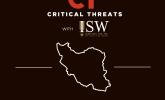Russian Offensive Campaign Assessment, December 4
December 4, 2022 - ISW Press
Ukrainian officials have indicated that Ukrainian forces plan to continue offensive operations over the coming winter to capitalize on recent battlefield successes and prevent Russian forces from regaining the battlefield initiative. Spokesperson of the Ukrainian Armed Forces Eastern Group Serhii Cherevatyi stated on December 4 that frozen ground enables heavy wheeled and tracked vehicles to advance and that Ukrainian forces are preparing such vehicles for winter operations. Cherevatyi also stated that low-quality mobilized recruits and Wagner Group personnel recruited from Russian prisoners are unprepared for combat in the winter. The Ukrainian Ministry of Defense (MoD) stated on November 20 that those who suggest the winter will pause hostilities “likely never sunbathed in January on the southern coast of Crimea,” suggesting that Ukrainian forces intend to continue counteroffensive operations over the coming winter that contribute toward the goal of retaking Crimea. Ukrainian Deputy Defense Minister Volodymyr Havrylov stated on November 18 that Ukrainian forces will continue to fight in the winter because any type of pause will allow Russian forces to reinforce their units and positions. Ukrainian officials’ prior statements on ongoing Ukrainian counteroffensive actions in Kherson Oblast are further evidence that these official statements on winter counteroffensive actions are indicators of continuing counteroffensive operations.







